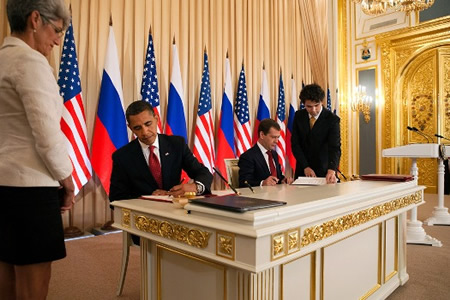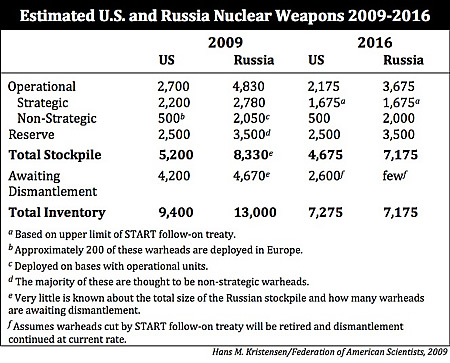START Follow-On: What SORT of Agreement?
 |
| Presidents Obama and Medvedev sign a joint understanding on a START follow-on treaty. |
By Hans M. Kristensen
The Joint Understanding for the START Follow-on Treaty signed by President Obama and Medvedev on July 6, 2009, commits the United States and Russia to “reduce their strategic warheads to a range of 1500-1675, and their strategic delivery vehicles to a range of 500-1100.”
Negotiators will still have to hammer out the details and draft a new treaty that the presidents can sign, hopefully by the end of the year, to be implemented in seven years.
The Summit was a good effort to revive U.S.-Russian relations, but seven years is a very long timeline for a START follow-on that doesn’t force either side to change very much. Does it rule out deeper cuts for the rest of the Obama administration?
Perceived and Actual Cuts
Although the actual treaty has yet to be written up, the Joint Understanding indicates that it will be a hybrid between the 1991 START treaty and the 2002 SORT agreement: limits on strategic delivery vehicle and deployed strategic warheads. It adopts the range-limit of the SORT agreement and continues some form of verification regime.
The lower limits of 1,500 strategic warheads and 500 delivery vehicles are meaningless because neither country is prohibited from going lower if it chooses to do so. The only real limit is the upper limit of 1,675 deployed strategic warheads and 1,100 strategic delivery vehicles.
Unfortunately, and this often happens when arms control agreements are covered, the news media has widely misreported what has been agreed to. Here are some examples:
* Washington Post: The agreement would “cut the American and Russian nuclear arsenals by as much as a third” by reducing the “the number of deployed nuclear warheads in each country to between 1,500 and 1,675….”
* Associated Press: The agreement would “slash nuclear stockpiles by about a third….”
* Washington Times: The agreement “would reduce nuclear warheads to between 1,500 and 1,675….”
In fact, the agreement only reduces deployed strategic warheads. It does not affect warheads held in reserve, non-strategic warheads, the size of the total stockpile, nor does it require dismantlement of any nuclear warheads.
The number of warheads in each country is secret and projections fraught with considerable uncertainty, but here is how the proposed START follow-on treaty might affect the nuclear arsenals of Russia and the United States:
Compared with the forces deployed as of 2009, the effect of the START follow-on appears to be a reduction of Russian deployed strategic warheads by approximately 40 percent, and a U.S. reduction of roughly 24 percent. The estimated effect on the total stockpile of either country is more modest: 14 percent fewer warheads for Russia and 10 percent for the United States. But that assumes the warheads cut by the START follow-on treaty would be retired rather than placed in the reserve, something the agreement does not require. The treaty itself requires no change in the size of the total stockpiles.
The reduction to 500-1,100 strategic delivery vehicles represents a significant reduction from the START ceiling of 1,600, at least on paper. In reality, however, the upper limit exceeds what either country currently deploys, and the lower level exceeds what Russia is expected to deploy by 2017 anyway. Therefore, a 500-1,100 limit doesn’t force either country to make changes to its nuclear structure but essentially follows current deployment plans.
The United States currently deploys approximately 798 strategic delivery vehicles; Russia approximately 620. But many of the Russian systems are being retired and not being replaced on a one-for-one basis so the entire force could shrink to less than 400 strategic delivery vehicles by 2016. To put in perspective; that would be less than the United States deploys in its ICBM force alone.
It is clear that claims that the Kremlin got everything while Washington gave away at the store are not accurate. Because Russia deploys more strategic warheads than the United States it also has to reduce more under the new treaty. And even after implementation, the United States will still have more – and better – strategic delivery vehicles than Russia.
So What?
Just like President Bush set a force level of 1,700-2,200 “operationally deployed strategic warheads” before the 2001 Nuclear Posture Review was completed, President Obama has now set what probably will be the overall force level of the ongoing Nuclear Posture Review. Not only will that review cut the number of warheads, it will probably also cut the number of delivery vehicles, perhaps a couple of the SSBNs and some of the ICBMs.
Yet some planners will probably argue against such cuts because Russia is compensating for its lower number of strategic delivery vehicles by deploying more warheads on each missile than the United States. In the minds of some, details like that still matter.
One architect of the Bush administration’s nuclear policy recently argued that the START follow-on agreement is a sellout by the Obama administration because it will “control or eliminate many elements of U.S. military power in exchange for strategic force reductions [Russia] will have to make anyway,” make the United States more vulnerable to a nuclear first strike, and make it harder to direct the nuclear force against other potential adversaries. Another warned that it would right-out “compromise” the U.S. nuclear deterrent.
Such arguments are both well known from the Cold War and out of sync with the 21st Century because they represent a cocooned form of strategic thinking that is preoccupied with Cold War scenarios. It is precisely because Russia is reducing that the United States should also trim its force; anything else will cater to those elements in Russia who want to stop and reverse the reduction. How could such a future possibly be in the interest of the United States or its allies (and, for that matter, Russia)?
And just why a U.S. arsenal of several thousand nuclear weapons would not be able to deter any other realistic adversary – to the extent anything can – is beyond me.
Internally the START follow-on will no doubt help the United States and Russia at the 2010 Review Conference of the Non-Proliferation Treaty. Yet even when the new treaty has been implemented in seven years, the two countries will still possess more than 90 percent of the world’s nuclear weapons, each with over 20 times more weapons than the next-largest nuclear power: China.
What’s Next?
Where does the new agreement fit in? It is explicitly described as a follow-on agreement to START, and U.S. and Russian officials have spoken of a step-by-step process that would initially extend START, produce a follow-on treaty, and also address non-strategic weapons and reserve warheads.
Yet the long timeline of the START follow-on agreement – seven years from the date of signing, five years after the SORT deadline – raises the question of whether this is as deep as they want to go in deployed strategic weapons. Since the limit of 1,100 delivery vehicles liberates either country from having to change their force structure, the agreement could be implemented very quickly – probably in a few months. So why set a timeline of seven years? I hope it does not rule out deeper cuts during even a second Obama administration.
Is the START follow-on the umbrella structure and the other steps – reserve weapons, counting rules, and non-strategic weapons – intended to follow underneath while it is being implemented?
Time will tell, but a couple of clarifying statements from the administration would be helpful.
Background Information: Full Text of Joint Understanding | U.S. Nuclear Forces 2009 | Russian Nuclear Forces 2009
The FY2026 National Defense Authorization Act (NDAA) paints a picture of a Congress that is working to both protect and accelerate nuclear modernization programs while simultaneously lacking trust in the Pentagon and the Department of Energy to execute them.
While advanced Chinese language proficiency and cultural familiarity remain irreplaceable skills, they are neither necessary nor sufficient for successful open-source analysis on China’s nuclear forces.
Satellite imagery has long served as a tool for observing on-the-ground activity worldwide, and offers especially valuable insights into the operation, development, and physical features related to nuclear technology.
This report outlines a framework relying on “Cooperative Technical Means” for effective arms control verification based on remote sensing, avoiding on-site inspections but maintaining a level of transparency that allows for immediate detection of changes in nuclear posture or a significant build-up above agreed limits.
